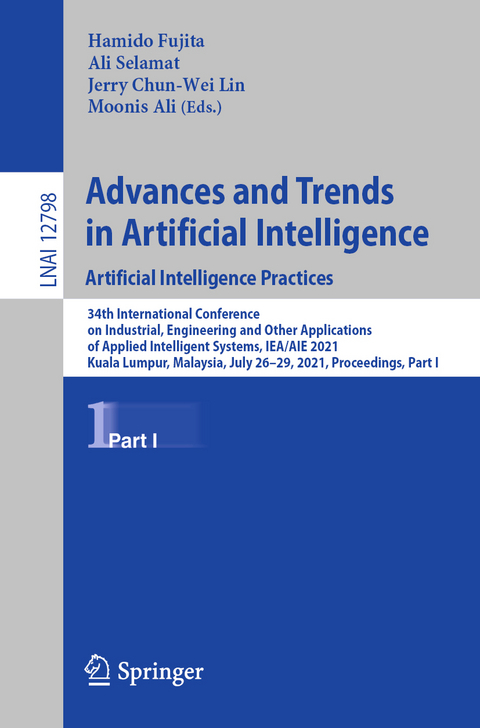
Advances and Trends in Artificial Intelligence. Artificial Intelligence Practices
Springer International Publishing (Verlag)
978-3-030-79456-9 (ISBN)
The 87 full papers and 19 short papers presented were carefully reviewed and selected from 145 submissions. The IEA/AIE 2021 conference will continue the tradition of emphasizing on applications of applied intelligent systems to solve real-life problems in all areas. These areas include the following:
Part I, Artificial Intelligence Practices: Knowledge discovery and pattern mining; artificial intelligence and machine learning; sematic, topology, and ontology models; medical and health-related applications; graphic and social network analysis; signal and bioinformatics processing; evolutionary computation; attack security; natural language and text processing; fuzzy inference and theory; and sensor and communication networks
Part II, From Theory to Practice: Prediction and recommendation; data management, clustering and classification; robotics; knowledge based and decision support systems; multimedia applications; innovative applications of intelligent systems; CPS and industrial applications; defect, anomaly and intrusion detection; financial and supply chain applications; Bayesian networks; BigData and time series processing; and information retrieval and relation extraction
Knowledge Discovery and Pattern Mining.- Fast Mining of Top-k Frequent Balanced Association Rules.- Towards Increasing Open Data Adoption through Stream Data Integration and Imputation.- Towards Efficient Discovery of Periodic-Frequent Patterns in Columnar Temporal Databases.- Data-Driven Simulation of Ride-Hailing Services using Imitation and Reinforcement Learning.- Discovering Spatial High Utility Itemsets in High-Dimensional Spatiotemporal Databases.- A Single-Stage Tree-Structure-Based Approach to Determine Fuzzy Average-Utility Itemsets.- Mining Episode Rules From Event Sequences Under Non-Overlapping Frequency.- Distributed mining of high utility time interval sequential patterns with multiple minimum utility thresholds.- Artificial Intelligence and Machine Learning.- Emergency Analysis: Multitask Learning with Deep Convolutional Neural Networks for Fire Emergency Scene Parsing.- Comparison of Consolidation Methods for Predictive Learning of Time Series.- Evolutionary Optimization of Convolutional Neural Network Architecture Design for Thoracic X-Ray Image Classification.- Understanding the Effects of Mitigation on De-identified Data.- Combining Siamese Network and Correlation Filter for Complementary Object Tracking.- Closed-Form Expressions for Global and Local Interpretation of Tsetlin Machines.- Explainable Reinforcement Learning with the Tsetlin Machine.- Sematic, Topology, and Ontology Models.- Semantic Technologies towards Missing Values Imputation.- An Improved Integer Programming Formulation for Inferring Chemical Compounds with Prescribed Topological Structures.- Automatic Classification for Ontology Generation by Pretrained Language Model.- Deep Learning Architecture for Topological Optimized Mechanical Design Generation with Complex Shape Criterion.- Computational Ontology and BIM Technology in Data-Driven Indoor Route Planning.- Collaborative Maintenance of EDOAL Alignments in VocBench.- DIKG2: a Semantic Data Integration Approach for Knowledge Graphs Generation from Web Forms.- Ontology-based Resume Searching System for Job Applicants in Information Technology.- An Approach to Expressing Metamodels' Semantics in a Concept System.- Medical and Health-Related Applications.- Birth-death MCMC Approach for Multivariate Beta Mixture Models in Medical Applications.- Intelligent Asthma Self-Management System for Personalised Weather-based Healthcare using Machine Learning.- Deep Forecasting of COVID-19: Canadian Case Study.- COVID-19 Genome Analysis using Alignment-Free Methods.- Deep Efficient Neural Networks for Explainable COVID-19 detection on CXR Images.- Predicting Psychological Distress from Ecological Factors: A Machine Learning Approach.- Graphic and Social Network Analysis.- Configuration model of employee competences in a social media team.- The Extended Graph Generalization as a Representation of the Metamodels' Extensional Layer.- WawPart: Workload-Aware Partitioning of Knowledge Graphs.- Analysis of Sentimental Behaviour over Social Data Using Machine Learning Algorithms.- Signal and Bioinformatic Processing.- A Large-scale Dataset for Hate Speech Detection on Vietnamese Social Media Texts.- Determining 2-Optimality Consensus for DNA structure.- Evolutionary Computation.- Utilizing Center-Based Sampling Theory to Enhance Particle Swarm Classification of Textual Data.- Conditional Preference Networks: Refining Solution Orderings beyond Pareto Dominance.- Enhancing Multi-Objective Evolutionary Neural Architecture Search with Surrogate Models and Potential Point-Guided Local Searches.- Insightful and Practical Multi-Objective Convolutional Neural Network Architecture Search with Evolutionary Algorithms.- Method for Automatic Furniture Placement Based on Simulated Annealing and Genetic Algorithm.- Attack and Security.- Recent Research on Phishing Detection through Machine Learning Algorithm.- A Transaction Classification Model of Federated Learning.- On the Assessment of Robustness of Telemedicine Applications against Adversarial Machine Learning Attacks.- A 1D-CNN Based Deep Learning for Detecting VSI-DDoS Attacks in IoT Applications.- Natural Language and Text Processing.- Hierarchical Transformer Encoders for Vietnamese Spelling Correction.- Fast and Memory-efficient TFIDF Calculation for Text Analysis of Large Datasets.- Collapsed Gibbs Sampling of Beta-Liouville Multinomial for Short Text Clustering.- Constructive and Toxic Speech Detection for Open-domain Social Media Comments in Vietnamese.- Fuzzy Inference and Theory.- The behaviour of the product t-norm in combination with several implications in Fuzzy PID controller.- Hub and Spoke Logistics Network Design for Urban Region with Clustering-Based Approach.- Sensor and Communication Networks.- Smartphone Sensor-Based Fall Detection using Machine Learning Algorithms.- IPR-SN: Intelligent Packet Routing in Satellite Networks Based on Distributed Deep Reinforcement Learning.
| Erscheinungsdatum | 21.07.2021 |
|---|---|
| Reihe/Serie | Lecture Notes in Artificial Intelligence | Lecture Notes in Computer Science |
| Zusatzinfo | XX, 636 p. 308 illus., 199 illus. in color. |
| Verlagsort | Cham |
| Sprache | englisch |
| Maße | 155 x 235 mm |
| Gewicht | 991 g |
| Themenwelt | Mathematik / Informatik ► Informatik ► Netzwerke |
| Informatik ► Theorie / Studium ► Künstliche Intelligenz / Robotik | |
| Informatik ► Weitere Themen ► Hardware | |
| Schlagworte | Applications • Artificial Intelligence • classification • Computational Linguistics • Computer Science • conference proceedings • Correlation Analysis • Databases • Data Mining • Informatics • Information Retrieval • Internet • machine learning • Natural Language Processing • Neural networks • NLP • Research • Robotics • Semantics • Signal Processing • World Wide Web |
| ISBN-10 | 3-030-79456-3 / 3030794563 |
| ISBN-13 | 978-3-030-79456-9 / 9783030794569 |
| Zustand | Neuware |
| Haben Sie eine Frage zum Produkt? |
aus dem Bereich


